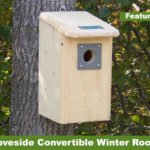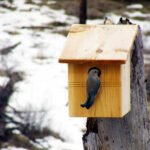 Last week, I wrote about ways to keep ants away from hummingbird feeders, but there are sometimes more alarming creatures out to get the nectar: wasps, hornets and yellow jackets.
Last week, I wrote about ways to keep ants away from hummingbird feeders, but there are sometimes more alarming creatures out to get the nectar: wasps, hornets and yellow jackets.
Flying insects, like all animals and bugs, contribute their own things to nature, but they can bully hummingbirds and orioles away by constantly swarming feeders. Some of the aggressive insects like yellow jackets will also attack and sting birds. Not to mention, these aren’t insects you’d want around your property where you or your kids are.
Unlike ants, which can be stopped with things as simple as a water moat, flying insects are a bit harder to keep away. Here are some things you can do from discouraging them from swarming your feeders.
Keep your yard clean
The first thing you should focus on is prevention. Limit or cover things in your yard that would attract these flying insects. For example, if you have a cat or dog, don’t leave their food sitting outside (this could also attract unwanted ants too). Cover any trashcans that may have food particles in it. You generally want to make sure there’s no standing water outside too. If you have a birdbath, consider getting one with moving water.
Buy feeders without any yellow
The only feeders really at risk of flying insects are hummingbird feeders and oriole feeders. Since wasps are attracted to the color yellow and can’t see red very well, getting a red feeder without any yellow is a good way to keep wasps from noticing it.
Get a dripless feeder
You can reduce the presence of flying insects by getting a feeder that doesn’t drip nectar. That will stop the scent of sugar from wafting in the air.
Take the feeders down for a few days
Once insects have found your feeders, they will usually be able to find them again if they’re in the same spot. So in order to get rid of them, you should take down the swarmed feeders for a few days. This is usually not a good idea because birds come to rely on these feeders, but if it’s getting overrun by unwanted insects, removing them for a few days will make the insects forget about them.
 Put up wasp traps
Put up wasp traps
Another solution is to hang up wasp traps near the feeder. Fill the traps with highly concentrated sugar water (you need to make it stronger and more desirable than the hummingbird nectar or oriole jelly). The wasps will fall into the trap and be unable to get out.
Get a hummingbird feeder with bee guards
Bee guards keep flying insects from entering a hummingbird feeder, but leave enough space for hummingbirds to drink the nectar. Many hummingbird feeders already come with bee guards, but you can also buy them from manufacturers like Perky-Pet.
For oriole feeders, switch jelly with live mealworms
Getting flying insects away from oriole feeders is a bit more difficult because they’re usually more open and can’t accommodate bee guards. So, aside from taking it down, you can also just replace the jelly at the feeder with live mealworms, which will still attract orioles.




51 Comments
Nice! Your blog is providing us great information to keep flying insects away from feeders.
I have honey bees in my yard and they have kept the wasps and all other bad bugs away. I have seven trees in my yard and I actually feed these bees every morning with a mason jar and lid with really small holes turned upside down on aquarium gravel so the bees will not drown. These bees do not sting or go out of thier way to harm me ever. After they eat the syrup I make every day the go away. Only a few bees are on the feeders. I do change the Hummer feeders every other day when the temp is 94 degrees here in Texas. I use to have problems with wasps now none ever try to make any nest. The honey bees probably belong to some bee keeper so I also put out water in a red plastic bowl with gravel and water just covering the rocks so they do not drown. I have had two kinds of six humming birds this whole summer and have five individual feeders on my windows and four hanging feeders with Aunt guards and bee gaurds inside the holes. I also have the feeders with the yellow ball bee gaurds. But you have to check every day. The bees will open the yellow balls so you have to check them to make sure they are snapped close. When I change the home made syrup the bees do not leave the feeders so I use a thin twig and just nudge them off. They never come after me or chase me. It is pretty amazing how they know I am just changing the syrup. The birds like the cooled syrup when I change it out that is for sure. I do also put ice cubes in my hanging water feeder for my squrels. I use to have hornets and paper wasps. This is the second year I do not have any in the back yard. I still think honey bees being fed is the best solution to feeding humming birds. I just spotted my first orange oreols in my yard a few days ago and a painted bunting bird a month ago.
For Ants…I have large black ones. Water moat and a thick sprinkling of ground cinnamon around the base of feeder polls has worked in keeping ants away. I found a cheap wasp & hornet trap. I add warm water after opening & hang it on a tree branch 20 feet away from everyone. It has yeast & brown sugar in it. It caught tons of mosquitos first couple days then the yellow jackets took over. Didn’t know we had yellow jackets until I found them inside. Neighbor coincidentally let me know this morning she found a YJ nest in her mulch bed under a rock. She ran like Hell. Now I know where the trap got them from. Yeast, Brown sugar & warm water does the trick. Easy recipe online.